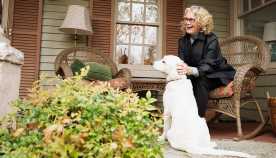AARP Eye Center
- right_container
- Health
- Money
- Work & Jobs
- Social Security
- Medicare
- Caregiving
- Games
- Travel
- More...
- Entertainment & Style
- Family & Relationships
- Personal Tech
- Home & Living
- Auto
- Staying Sharp
- Podcasts
- Videos
Audubon Nebraska
The Audubon Society of Omaha receives the Omaha World-Herald's Conservationist of the Year Award for their efforts on behalf of Heron Haven.
1998 - Audubon purchases the O'Brien Ranch, preserving one of the largest parcels of tallgrass prairie left in the state. The ranch is renamed Spring Creek Prairie, and the organization embarks on an effort to turn the property into a premier prairie education center and sanctuary.
The Big Bend Audubon Society absorbs the Grand Island and Hastings chapters.
1997 - Audubon opens a state office in Nebraska.
Helped by the participation of Audubon and the Platte River Whooping Crane Trust in the relicensing of Kingsley Dam, the states of Nebraska, Wyoming, and Colorado sign a cooperative agreement to address endangered species issues on the central Platte with a basin-wide approach.
1996 - Audubon Nebraska defends the Nebraska Game and Parks Commission's application to protect flows for fish and wildlife on the Platte River. With only one week to respond to a secret agreement between three of the seven members on the Commission and a powerful coalition of irrigators, power districts, farm groups, and NRDs, Audubon ran a full-page ad in the Omaha World-Herald, which forced a delay and eventual rejection of the agreement.
1995 - The Wildcat Audubon Society plays a major role in raising funds and community support for the completed Wildcat Hills Nature Center. The facility is opened for limited use by the Nebraska Game and Parks Commission.
1994 - The Wachiska Chapter obtains a conservation easement on the Wulf Prairie, which marks the start of an effort to preserve prairies throughout the 17-county region the chapter serves.
1993 - Audubon co-sponsors an event at the University of Nebraska library commemorating John James Audubon's 1843 expedition up the Missouri River. The event includes a showing of Audubon prints and talks by his great-granddaughter.
1992 - The Audubon Society of Omaha succeeds in saving a 25-acre wetland in the middle of the city, naming it Heron Haven.
1991 - President Bush signs legislation designating the Niobrara River as a National Wild and Scenic River, rewarding years of effort by Nebraska's Audubon volunteers to achieve the designation, which included taking trips to Washington, D.C. to testify.
1990 - Nine years of Audubon opposition to the Two Forks Dam culminates when the Environmental Protection Agency rules against construction.
The Audubon Society of Omaha receives extensive publicity for "bar hopping," as they come to the Rowe Sanctuary to remove woody growth from the islands and sandbars on the river.
The National Audubon Society acquires 218 acres on the Niobrara River to preserve as a sanctuary, which later becomes the Fred Thomas preserve owned by the Nebraska Game and Parks Commission.
1989 - "Crane River" debuts on The World of Audubon. Narrated by Leonard Nimoy, the film highlights the importance of the Platte River for cranes and other wildlife, as well as the various threats from additional water projects such as the Two Forks Dam near Denver.
1998 - The Audubon Society of Omaha teams up with the Raptor Recovery Center and the Nebraska Game and Parks Commission to release 22 peregrine falcons on the roof of the Woodmen Tower in Omaha.
1986 - The Norden Dam on the Niobrara River is de-authorized, much to the delight of many Audubon members whose tireless efforts were instrumental in helping to preserve the river.
Governor Bob Kerrey signs a proclamation designating April as Audubon month, commemorating the 200th birthday of John James Audubon.
1985 - To give Audubon chapters a statewide voice and a means to network, chapter leaders form the Nebraska Audubon Council.
The National Audubon Society hires a manager for Rowe Sanctuary and Audubon members volunteered workdays to help improve the sanctuary.
1981 - The Wachiska Chapter holds its first annual Prairie Festival.
1980 - Audubon helps to organize landowners along the Niobrara River to oppose construction of the Norden Dam.
1978 - The Wildcat Audubon Society is chartered as an Audubon chapter, taking its name from the beautiful Wildcat Hills near Scottsbluff. The roots of the chapter extend back to 1952, when the group first formed to be a nature club. Chapters were also formed in northeast Nebraska and north central Nebraska near the Niobrara River.
The Wachiska Chapter leases Nine-Mile Prairie from the Lincoln Airport Authority, starting a sequence of events that will culminate in the preservation of the historic prairie by the University of Nebraska Foundation.
1976 - The Wachiska Chapter establishes the Raptor Recovery Center as a Bicentennial project.
1975 - Water projects that would have further drained vital flows needed by sandhill cranes, whooping cranes, and other migratory waterfowl were being proposed for the Platte River. Led by Audubon, the Midstate Project, the largest and most threatening of the proposed diversions, is defeated in a local referendum. This effort led directly to the formation of the Big Bend Audubon Society in Kearney, as well as chapters in Grand Island and Hastings.
1974 - National Audubon Society purchases the Lillian Annette Rowe Sanctuary near Gibbon, preserving four miles of the finest remaining crane habitat on the river. The sanctuary was also the first land to be protected for migratory waterfowl on the central Platte.
1973 - The Wachiska Audubon Society forms in Lincoln and serves 17 counties in southeast Nebraska.
1971 - The Omaha Birding Club votes to become the Audubon Society of Omaha, the first officially chartered chapter in the state.
1970 - The first Spring River Conference is held in Grand Island. The conference would soon move to Kearney and eventually be renamed the Rivers and Wildlife Celebration. It is one of the longest-running wildlife events in the country.
1913 - The National Association of Audubon Societies partners with the City of Valentine to construct the bison enclosure at the Fort Niobrara National Wildlife Refuge. In the early part of the century, Audubon was instrumental in bison preservation because of the efforts of its vice president, who was also president of the American Bison Society.
AARP Events for Denton
-
Functional Fitness with Basic Body Movements
Monday, Feb 17, 2025 at 8:00 a.m. CT
Zoom
Online Event
-
Moving With Milly for Improved Mobility
Monday, Feb 17, 2025 at 10:00 a.m. CT
Zoom
Online Event
-
Sit to Fit: Seated Exercises for All Levels
Monday, Feb 17, 2025 at 10:00 a.m. CT
Facebook and YouTube
Online Event

with Automatic Renewal
- Immediate access to your member benefits
- Discounts on travel and everyday savings
- Subscription to AARP The Magazine
- FREE second membership

























































